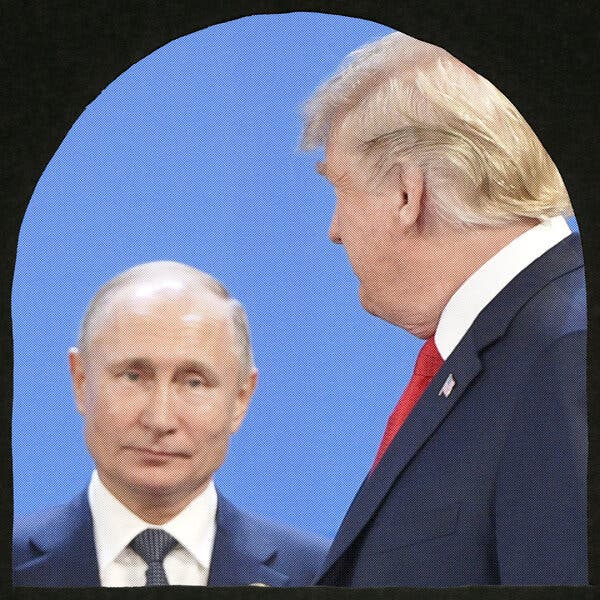Donald Trump has expressed a strong desire to end the war in Ukraine, a goal shared by Ukrainian President Volodymyr Zelensky and numerous other global leaders. However, Russian President Vladimir Putin remains resolutely opposed to peace. For Putin, the war in Ukraine serves as the political, psychological, and economic cornerstone of his regime.
This fundamental imbalance largely dooms efforts at negotiated peace and explains the absence of meaningful talks in the three and a half years since Russia launched its full-scale invasion of Ukraine. Despite this, Trump claims to have a solution. He asserts he can leverage his negotiating skills and intensify economic pressure until Putin is compelled to cease hostilities.
Amidst his dramatic social media posts, shifting timelines, and contradictory announcements — such as the fluctuating conditions for meeting Putin — Trump’s Russia policy largely mirrors the unsuccessful strategies pursued by both the Biden and previous Trump administrations, as well as the Obama administration before them. For over a decade, the United States has responded to Russian aggression primarily through incremental economic sanctions and threats. The form sanctions take—whether tariffs or financial penalties—does not fundamentally change this approach.
The prevailing theory behind sanctions is that economic pressure destabilizes authoritarian regimes, potentially forcing leaders to alter their course. One scenario envisions widespread hardship—rising unemployment, inflation, scarcity—sparking popular unrest or even riots. Another expects economic contraction and loss of access to foreign markets to anger elite factions, possibly triggering a coup or compelling leadership changes.
Yet this theory is flawed. When sanctions work, they primarily impoverish ordinary citizens, while elites retain wealth, widening inequality. Instead of fomenting resentment against the regime, sanctions often unify society against the foreign adversary imposing them. The enemy is distant and abstract, while local elites control media narratives, jobs, and resources, making them more tolerable targets of loyalty than the external foe. Additionally, severe hardship tends to push the populace to focus solely on survival rather than political engagement.
Regarding the elite coup scenario, Russia illustrates how sanctions can backfire. Wealthy Russians displaced by frozen assets and lost Western market access have relocated to places like Dubai or returned to Moscow. A shrinking economic pie does not incite elites to overthrow their leader—a risky gamble with limited chances of success—but rather heightens their competition for remaining resources.
Typically, sanctions are implemented gradually following stern warnings, allowing regimes to prepare. Russia has subsidized domestic production to replace imports, prioritized new export markets, and found third countries to reroute oil and acquire dual-use technologies. These tactics have strengthened Russia’s ties with other sanctioned states like Iran, which has become a key partner in Russia’s drone warfare.
Despite these realities, successive U.S. administrations have promoted sanctions as their main tool to change Putin’s behavior. President Biden has imposed multiple sanction rounds, none as “devastating” as promised. Trump added a 25% tariff on India—ostensibly penalizing its Russian oil imports—and vowed further tariffs against Russia’s trade partners. Year after year, the same strategies repeat with hopes for different results. In this regard, Trump’s approach is no more radical than those before him.
For Trump, who consistently assumes money motivates all actors, grappling with the limitations of economic pressure is especially challenging. Many Western analysts have suggested Putin would withdraw from Ukraine once the war’s costs—especially personal—became unbearable. However, Putin values power even more than wealth: the eternal power he wields domestically through territorial expansion and the global influence he gains by instilling fear in other leaders. By agreeing to meet Putin, Trump inadvertently grants the Russian leader a powerful symbolic victory.
Trump further empowers Putin by consenting to negotiations without Ukrainian President Zelensky’s presence and sidelining the European Union. This reinforces Putin’s long-standing narrative that the conflict is fundamentally between Russia and the United States.
Once Putin enters the negotiation room, he will have secured his goals along with the opportunity to make provocative statements—such as reaffirming historical claims over Alaska. Should talks fail to yield an agreement, Putin loses nothing, whereas Trump risks damaging his reputation if he exits empty-handed. This dynamic may pressure Trump into conceding.
The peace terms Russia proposed in June essentially reiterate four longstanding demands: territorial concessions including areas not currently occupied; an end to Western military aid to Ukraine; guarantees that Ukraine will never join NATO; and a change in Ukrainian leadership. While Trump might accept these conditions, Zelensky almost certainly will not. Putin has little incentive to soften his stance.
If Putin wished to help Trump save face—though this seems unlikely—they might reach a limited ceasefire. Such an agreement could be contingent on Ukrainian withdrawal from parts of eastern Ukraine, forcing Kyiv to abandon strategically vital positions. This would allow Russia to regroup and potentially resume attacks under the pretext that Ukraine failed to meet demands. Other proposals include banning warfare on enemy territory or establishing an aerial truce. While such agreements would save lives in Ukrainian cities like Kyiv and Odesa, they would also reduce Ukraine’s ability to strike Russian cities increasingly targeted by drone attacks.
For Ukraine, an aerial ceasefire carries a significant strategic cost. The country would remain at war, governed under emergency measures. Families would stay separated, with many women and children fleeing to Western Europe while men remain to fight. Most tragically, casualties would continue on frontlines and in cities near the conflict zone, including Kharkiv, Ukraine’s second-largest city located about 30 kilometers inland.
Ukraine’s sole bargaining chip is its capacity to attack within Russian territory. Russian airports frequently suspend operations due to drone strikes. Moscow’s mayor reports drone interceptions similarly to Kyiv’s mayor. While insufficient to destabilize Putin’s regime, these attacks create unease. If drone strikes ceased, the war—still called a “special military operation” in Russian propaganda—might seem more remote.
The only factor likely to compel Putin to negotiate earnestly is the threat of military defeat. Without this prospect, he is content to let the war drag on indefinitely. Contrary to Trump’s assumptions, Putin is less concerned about economic losses and indifferent to soldier casualties. The Kremlin has referenced historical precedent, citing the 21-year Great Northern War with Sweden starting in 1700, implying this conflict could last decades.
This protracted war is no mere abstraction. The grim reality is captured in the Ukrainian documentary “2000 Meters to Andriivka,” directed by Mstyslav Chernov. The film chronicles a Ukrainian brigade’s months-long effort to reclaim a small village just two kilometers away.
The documentary reveals the enormous horrors of war—entire cities destroyed, fertile land turned into minefields, rows of indistinguishable new graves—and the stark smallness of it: handfuls of soldiers armed with semi-automatic rifles killing and dying one by one, taking prisoners singly, fighting trench by trench, in terrifyingly slow minutes stretched into hours. A platoon commander recounts dreaming of combat and waking amidst it, describing the war as a nightmare none can escape.
Intermittently, Western commentators’ voices intrude offscreen with remarks such as:
“Western confidence is likely to wane.”
“If we don’t achieve results here, Ukraine may have to consider alternative plans, including territorial concessions for peace.”
“Western officials have expressed disappointment over a much-publicized counteroffensive.”
“Russia has millions more men to deploy. There is no path to military victory here, only more death.”
“How sustainable is this level of support when there is no end in sight to the war?”
At its core, these questions are straightforward. Ukraine cannot win the war as currently fought. The conflict can drag on indefinitely, resulting in mounting casualties. But this is not the only possible outcome. The United States and NATO have always had the means to end the war decisively—by defeating Putin. Instead, they have consistently chosen not to pursue this option, relying on failed policies. In this respect, Trump’s approach offers more spectacle but little substantive difference.


0 Comments
No comments yet. Be the first to comment!